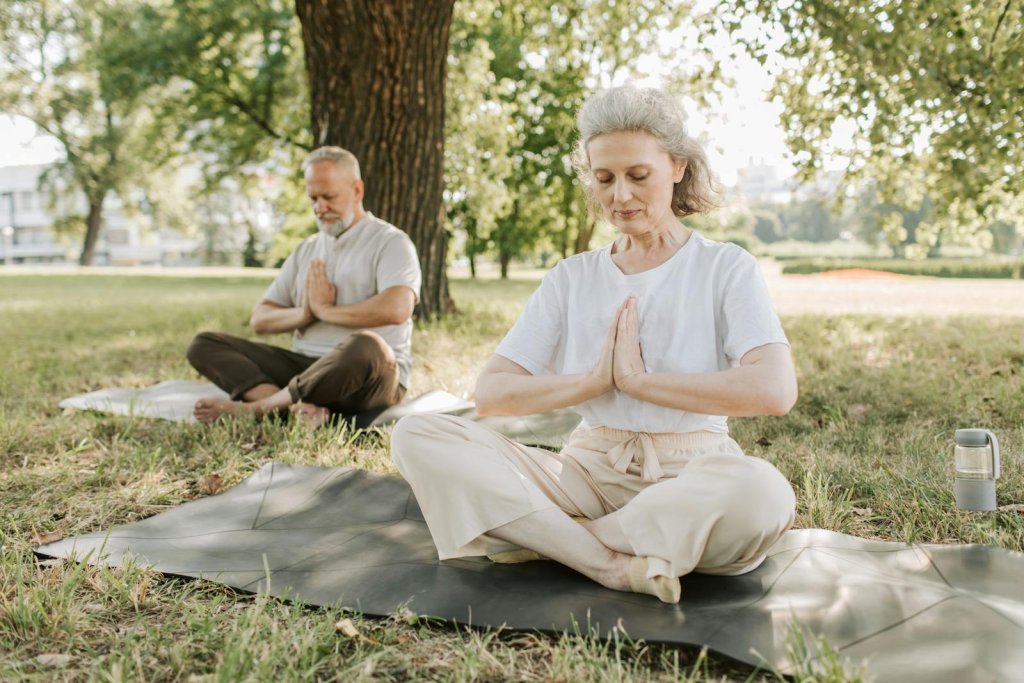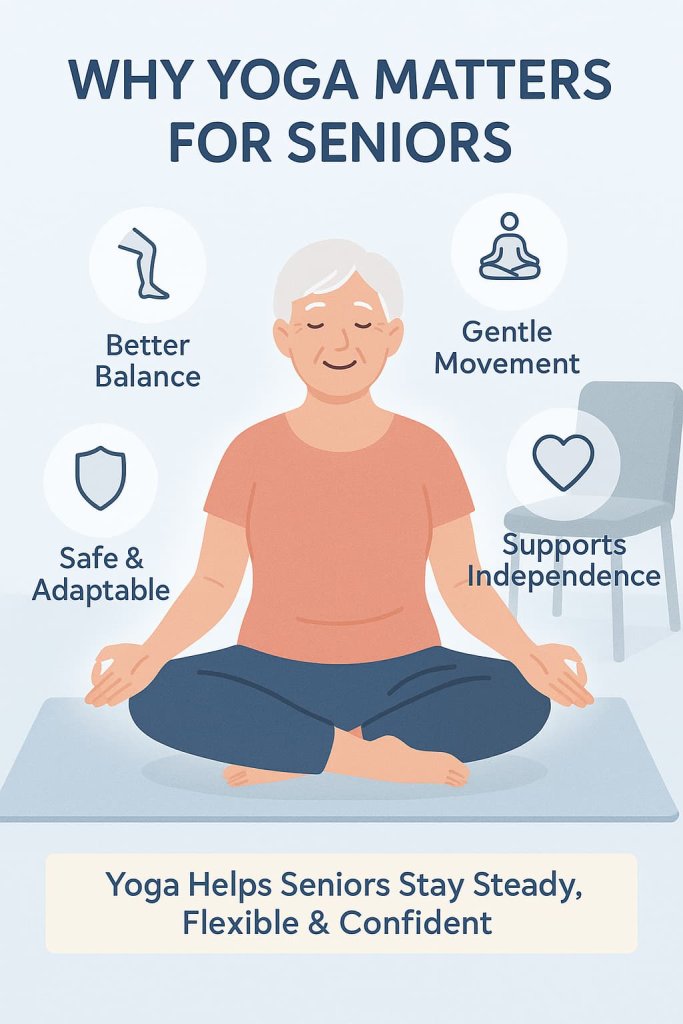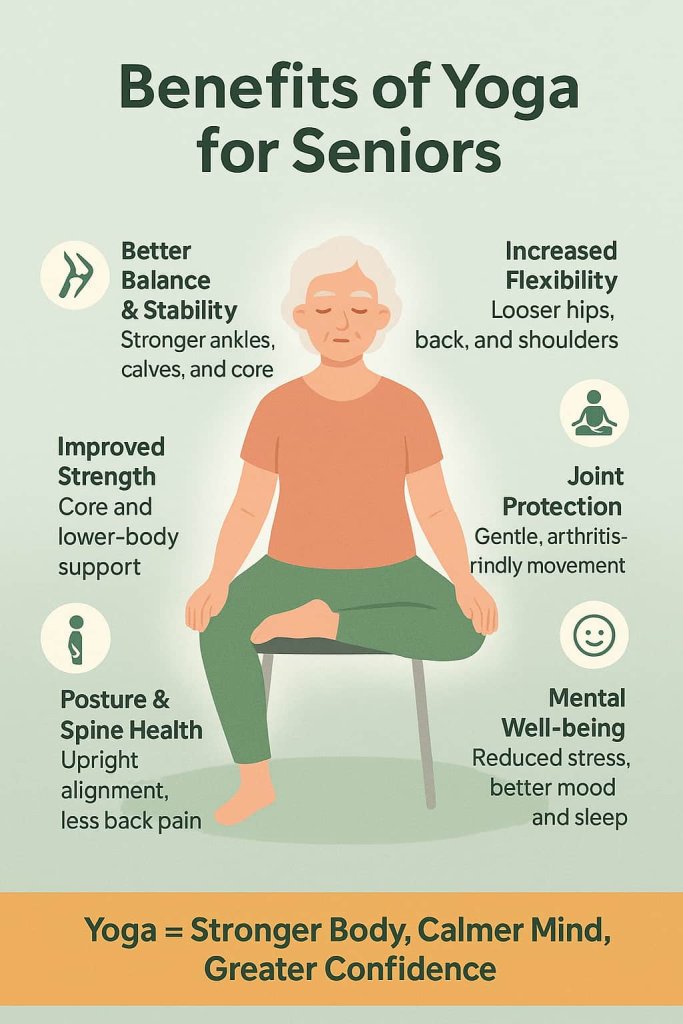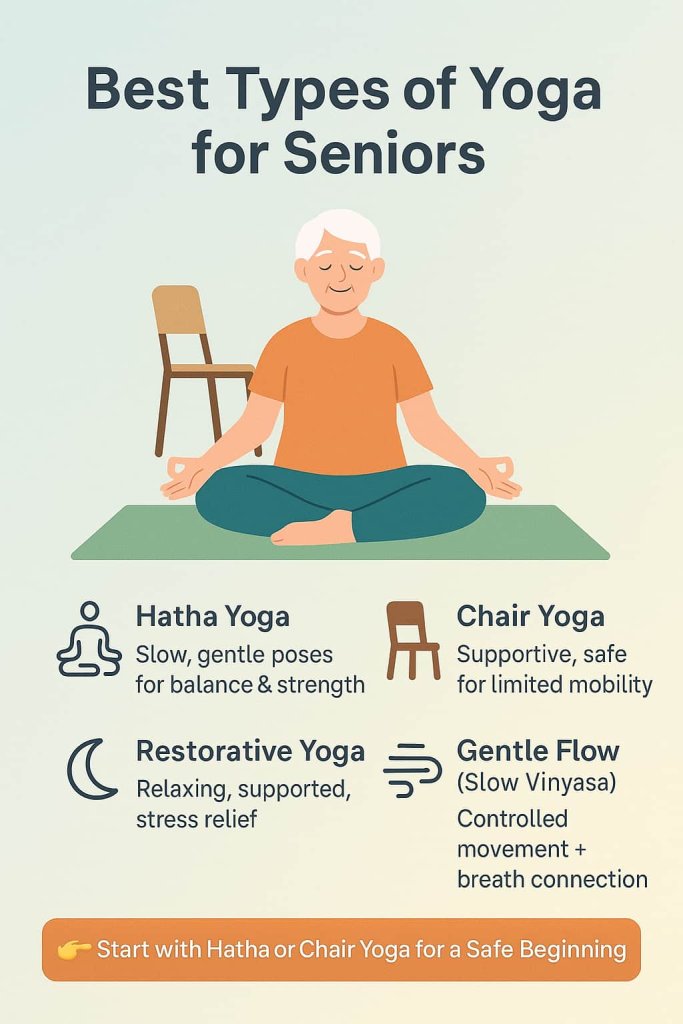Yes, yoga is one of the best low-impact exercises for seniors to improve balance and mobility. Studies show that regular yoga practice strengthens muscles, enhances flexibility, and lowers the risk of falls in older adults (Harvard Gazette, 2023).

For seniors, mobility means independence—being able to climb stairs, walk steadily, and enjoy daily life with confidence. Simple yoga poses, from Mountain Pose to Chair Yoga, can make a big difference. In this guide, you’ll learn the top poses, benefits, beginner tips, and safety advice to start safely and effectively.
Why Yoga Matters for Seniors
Aging often brings challenges such as reduced flexibility, weaker balance, and increased fall risk. For many seniors, these issues can limit independence and confidence in daily life.

Yoga matters because it directly addresses these concerns—it combines gentle movement, balance training, and mindful breathing in one safe practice. Unlike high-impact exercises, yoga is adaptable and can be modified with props or chair support, making it accessible to nearly everyone.
Benefits of Yoga for Seniors
Practicing yoga on a regular basis provides seniors with measurable health improvements and greater confidence in daily movement. Key benefits include:

- Better Balance & Stability – Strengthens ankles, calves, and the core, lowering the risk of falls.
- Increased Flexibility – Keeps joints mobile, easing stiffness in the hips, back, and shoulders.
- Improved Strength – Builds lower-body and core muscles that support standing and walking.
- Joint Protection – Gentle movements relieve pressure on arthritic joints and support overall mobility.
- Posture & Spine Health – Encourages upright alignment and reduces back or neck discomfort.
- Mental Well-being – Breathing and mindfulness reduce stress, boost mood, and improve sleep.
Best Types of Yoga for Seniors
Not all yoga styles are senior-friendly. These are the safest and most beneficial:

- Hatha Yoga – Slow, gentle poses focusing on strength and balance.
- Chair Yoga – Uses a chair for support; ideal for limited mobility or balance concerns.
- Restorative Yoga – Relaxing, supported poses that relieve tension and improve recovery.
- Gentle Flow (Slow Vinyasa) – Combines controlled movement with breath for flexibility.
👉 If you’re new to yoga, start with Hatha or Chair Yoga and gradually progress.
Top Yoga Poses for Balance & Mobility
1. Mountain Pose (Tadasana)
Why it helps: Improves posture, body awareness, and balance.
How to do it:
- Stand tall with feet hip-width apart.
- Press evenly into both feet.
- Engage thighs and lengthen spine.
- Relax shoulders and breathe deeply.
Trainer Tip: Imagine a string pulling you upward from the crown of your head.
2. Tree Pose (Vrksasana)
Why it helps: Builds single-leg stability and strengthens ankles and calves.
How to do it:
- Stand tall, shift weight onto one foot.
- Place the other foot on ankle or calf (avoid the knee).
- Hands at chest or raised overhead.
- Hold 15–30 seconds per side.
Trainer Tip: Use a chair or wall for balance if needed.
3. Warrior II (Virabhadrasana II)
Why it helps: Strengthens legs, hips, and improves joint mobility.
How to do it:
- Stand with feet wide apart.
- Turn one foot outward, bend that knee.
- Extend arms parallel to the ground.
- Keep chest open and gaze forward.
Trainer Tip: Align the bent knee directly above the ankle.
4. Cat-Cow Stretch (Marjaryasana-Bitilasana)
Why it helps: Increases spinal mobility and reduces stiffness.
How to do it:
- Start on hands and knees or place hands on a chair.
- Inhale: arch back, lift head (Cow).
- Exhale: round spine, tuck chin (Cat).
- Repeat 6–8 cycles.
Trainer Tip: Breathe deeply and move slowly with control.
5. Seated Forward Fold (Modified Paschimottanasana)
Why it helps: Stretches hamstrings and lower back, supporting mobility.
How to do it:
- Sit tall on a chair or mat.
- Extend legs forward (slightly bent if needed).
- Hinge at hips, reach toward feet.
- Hold 20–30 seconds.
Trainer Tip: Use a yoga strap around feet for easier reach.
6. Bound Angle Pose (Baddha Konasana)
Why it helps: Opens hips and improves pelvic mobility.
How to do it:
- Sit with feet together, knees bent outward.
- Hold feet or ankles.
- Sit tall, gently pressing knees down.
Trainer Tip: Place pillows under knees for support.
7. Chair Yoga Variations
Why it helps: Safer option for those with arthritis or limited mobility.
Examples:
- Seated Mountain Pose – improves posture.
- Chair Twists – supports spinal flexibility.
- Heel Raises – strengthens ankles and calves.
- Seated Side Bends – increases lateral mobility.
Trainer Tip: Always practice on a sturdy chair without wheels.
Safety Tips for Seniors Practicing Yoga
- Get medical clearance if you have arthritis, osteoporosis, or heart issues.
- Use props (blocks, straps, chairs, walls) for added support.
- Avoid deep lunges or overstretching.
- Practice on a non-slip mat in a clutter-free space.
- Start with 10–15 minutes and gradually extend sessions.
Beginner Tips for Seniors Starting Yoga
- Begin with 2–3 sessions per week of 20–30 minutes.
- Choose senior-friendly classes (Chair Yoga, Gentle Hatha).
- Listen to your body—stop if you feel pain or dizziness.
- Use props and supports for stability.
- Practice slow breathing alongside poses.
FAQ: Yoga for Seniors
1. Can seniors over 70 practice yoga?
Yes. With props and modifications, yoga is safe and highly beneficial even at 70+.
2. How often should seniors do yoga?
Aim for at least 2–3 sessions per week for noticeable results.
3. Does yoga improve balance?
Yes. Studies confirm yoga enhances balance and reduces fall risk in seniors (PMC, 2022).
4. What yoga style is best for beginners?
Hatha Yoga and Chair Yoga are the safest starting points.
5. Can yoga replace strength training for seniors?
Yoga builds strength, but combining it with resistance training offers the best benefits.
6. Is yoga safe with arthritis?
Yes, with gentle modifications and chair support. Avoid deep knee bends.
7. Do I need equipment?
Only a yoga mat and comfortable clothing; optional props include blocks, straps, or a chair.
Conclusion
Yoga is one of the most effective, low-impact ways for seniors to improve balance, mobility, and independence. Whether you stand tall in Tree Pose or relax into Chair Yoga, consistency is the key to long-term benefits.
👉 Start small, practice safely, and build confidence one pose at a time. With yoga, every step becomes steadier and stronger.
